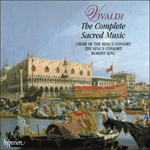
Welcome to Hyperion Records, an independent British classical label devoted to presenting high-quality recordings of music of all styles and from all periods from the twelfth century to the twenty-first.
Hyperion offers both CDs, and downloads in a number of formats. The site is also available in several languages.
Please use the dropdown buttons to set your preferred options, or use the checkbox to accept the defaults.

RV601, in G major, is a true virtuoso piece for a soprano (originally a castrato) able to reach D in alto. The galant inflections of its melodic lines remind one of the Neapolitan opera that had conquered Venice only a few years earlier. It contains some vivid word-painting, examples of which are the sustained trilled note on the first syllable of ‘saeculum’ (eternity) in movement 2; the long ascent representing sunrise in movement 3; the registral contrast of ‘caelo’ (heaven) and ‘terra’ (earth) in movement 4; the fierce urgency with which the poor are raised up from the dust in movement 5; the mechanically repetitive crotchets illustrating the word ‘collocet’ (set) in movement 6. The most memorable movement is unquestionably the seventh, ‘Gloria Patri’, in which the composer calls for an obbligato flute, which for Venice was still a relatively new instrument. Vivaldi certainly encountered the flautist Johann Joachim Quantz, a member of the Dresden orchestra, on the latter’s visit to Venice in 1726, and this movement can be seen as a retrospective homage to, and renewal of musical contact with, the eminent German.
from notes by Michael Talbot © 2001
RV601, en sol majeur, est une véritable pièce virtuose pour une voix de soprano (originellement un castrat) capable d’atteindre ré in alto. Les inflexions galantes de ses lignes mélodiques rappellent l’opéra italien, qui avait conquis Venise quelques années seulement auparavant. Elle recèle quelques éclatants madrigalismes, tels la note trillée tenue sur la première syllabe de «saeculum» (éternité), dans le mouvement 2; la longue ascension symbolisant le lever du soleil dans le mouvement 3; le contraste de registre entre «caelo» (ciel) et «terra» (terre) dans le mouvement 4; l’urgence féroce avec laquelle les pauvres sont relevés de la poussière dans le mouvement 5; les noires, mécaniquement répétitives, illustrant le mot «collocet» (asseoir) dans le mouvement 6. Le mouvement le plus mémorable est incontestablement le septième, «Gloria Patri», pour lequel Vivaldi fait appel à une flûte obbligato, un instrument alors relativement nouveau à Venise. Le compositeur rencontra certainement le flûtiste Johann Joachim Quantz, membre de l’orchestre de Dresde, de passage à Venise en 1726, et l’on peut voir en ce mouvement un hommage rétrospectif à l’éminent Allemand, un renouement musical aussi.
extrait des notes rédigées par Michael Talbot © 2001
Français: Hyperion Records Ltd
RV601 in G-Dur ist eine wahrhaft virtuose Partie für einen Sopran (ursprünglich für einen Kastraten), der das hohe D singen kann. Die Melodielinien im galanten Stil erinnern an die neapolitianische Oper, die erst wenige Jahre zuvor Venedig erobert hatte. Das Werk enthält anschauliche Tonmalerei - Beispiele dafür sind der ausgehaltene Triller auf der ersten Silbe von „saeculum“ (Ewigkeit) im zweiten Satz, die lang ansteigende Linie im dritte Satz, die einen Sonnenaufgang darstellt, der Kontrast zwischen den Stimmregistern von „caelo“ (Himmel) und „terra“ (Erde) im vierten Satz, die ungestüme Eindringlichkeit, mit der im fünften Satz die Armen aus dem Schmutz erhöht werden, sowie die mechanisch wiederholten Viertelnoten, die im sechsten Satz das Wort „collocet“ (setzt) illustrieren. Der beeindruckendste Satz ist fraglos der siebte, „Gloria Patri“, für den der Komponist eine obligate Flöte verlangt, die in Venedig damals noch ein relativ neues Instrument war. Vivaldi hat Johann Joachim Quantz, der als Flötist im Dresdener Orchester tätig war, mit Sicherheit bei dessen Besuch 1726 in Venedig kennengelernt, und dieser Satz kann als rückschauende Hommage an und Erneuerung des musikalischen Kontakts zu dem bedeutenden Deutschen betrachtet werden.
aus dem Begleittext von Michael Talbot © 2001
Deutsch: Anne Steeb/Bernd Müller
 Vivaldi: The Complete Sacred Music Vivaldi: The Complete Sacred Music‘For King's sterling service to the Vivaldian cause, one of his most important recording and satisfying projects to date, I am thankful’ (Gramophone) ‘If you're waiting for the perfect collection of Vivaldi's sacred music, this is it. It was a happy day when this beautiful boxed set arrived in my m ...» More |

